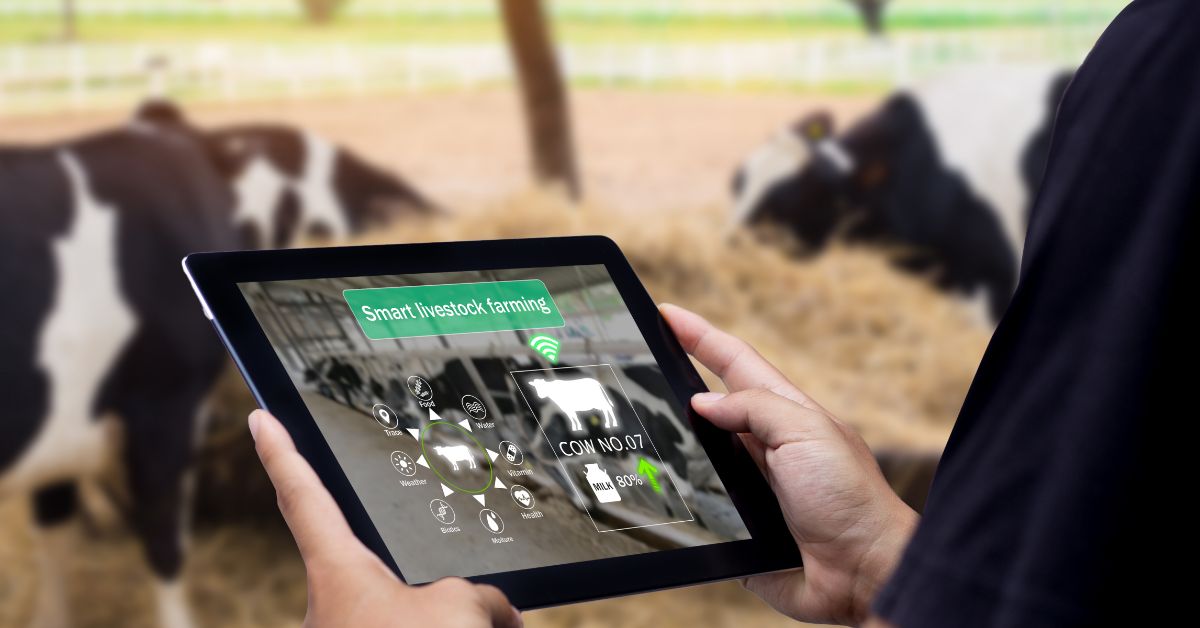Livestock Monitoring Using Sensor Data & Machine Learning
Livestock monitoring is the practice of raising and caring for domesticated animals for food, clothing, or transportation. The process involves feeding, breeding, disease prevention, and general monitoring.
Traditionally, livestock monitoring has been a labour-intensive and time-consuming process in the agricultural sector. However, recent advances in machine learning algorithms and sensor technology have enabled the automation of this process and the collection of valuable data on livestock health and behaviour.
For example, sensors placed on animals help collect data on their movements, behaviour, and psychological signals like temperature and heart rate. This data is then analyzed using machine learning algorithms to detect patterns and anomalies that can indicate health issues or changes in behaviour.
Challenges of Livestock Monitoring Using Smart Farming Tools
High Cost of Technology: The initial cost of acquiring smart farming tools can be expensive, making it difficult for small-scale farmers to afford them. However, the price of intelligent farming tools has decreased as they become more prevalent. Additionally, some companies offer leasing programs where farmers can rent the equipment.
Technical Expertise: Smart farming tools can be complex; farmers need technical expertise to set up and use them effectively. However, many manufacturers offer training programs to teach farmers how to operate and maintain the equipment. In addition, several agricultural organizations offer courses and workshops on using machine learning and sensors.
Data Privacy and Security: The collection and storage of animal data can be sensitive, and farmers need to keep the information secure and protected from unauthorized access. One potential solution is using machine learning algorithms to encrypt sensitive data, which can only be authorized with the correct decryption key.
Data Overload: Smart farming tools generate a large amount of data, making it challenging for farmers to manage and interpret it effectively. One solution is to use machine learning algorithms to analyze this data automatically. By using machine learning, farmers can identify patterns in the data and make data-driven, informed decisions based on the insights.
In conclusion, while smart farming tools have the potential to revolutionize livestock management, they come with their own set of challenges. However, with the right intelligent farming tools, training, and support, farmers can improve animal health and productivity, reduce costs and increase profits.
Benefits of Livestock Monitoring Using Smart Farming Practices
The primary benefit of livestock monitoring is the early detection of health issues. For example, changes in the body temperature or heart rate can be early indicators of illness, and machine learning algorithms detect the problem before it becomes severe. This reduces the risk of animal loss and increases productivity.
Another benefit of using sensor data and machine learning is improved animal welfare. By tracking animals’ movements and behaviour, farmers can ensure that their animals have access to adequate food, water, and shelter and are not under undue stress or discomfort. This reduces the incidence of diseases or injuries and improves animals’ overall health and well-being.
In addition to health and welfare benefits, livestock monitoring also improves the efficiency and profitability of farming operations. By collecting data on animal behaviour and activity, farmers can optimize their feeding and breeding programs, reduce waste, and increase productivity. This can lead to increased profits and improved sustainability of the operation.
Machine learning algorithms help optimize the breeding of livestock. These algorithms can predict the likelihood of successful breeding by analyzing genetic data and other parameters like weight and age. This can help farmers to select the best breeding pairs and increase the chances of producing healthy offspring.
Lastly, using predictive analytics is proving to be extremely beneficial for farmers. By analyzing historical data on livestock behaviour and health, among other factors, machine learning algorithms predict future behaviour and health risks. This information helps farmers take preventive measures to reduce the risk of disease outbreaks or other health problems.
Conclusion
Livestock monitoring using sensor data and machine learning is an exciting new development in the agriculture industry, offering a range of benefits. This technology provides real-time animal behaviour, health, and location data, allowing farmers to identify and address issues quickly. This results in better animal welfare, increased productivity, and reduced costs.
While there are challenges associated with this technology, the potential benefits make it an area of research and development worth exploring further. This technology has immense potential to improve the overall sustainability and efficiency of the livestock industry. As technology continues to advance, it is clear that livestock monitoring using sensor data and machine learning will become an integral part of modern agriculture practices.

